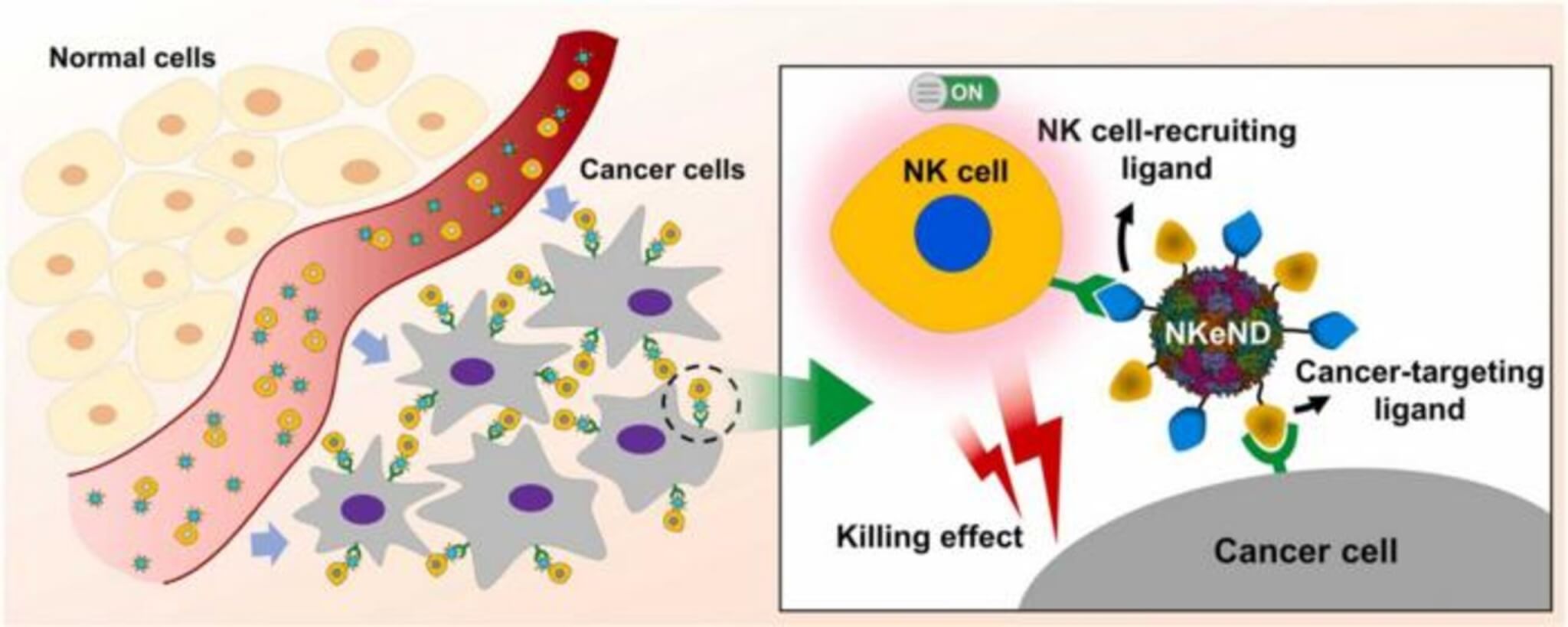ULSAN, South Korea — South Korean researchers from the Ulsan Institute of Science and Technology (UNIST) have developed a cutting-edge method to treat cancer using tiny, specialized devices called “nanodrones.” These revolutionary nanodrones are engineered to specifically target and destroy cancer cells.
To understand this, we first need to know about Natural Killer (NK) cells. NK cells are a type of white blood cell that play a vital role in defending our body against cancer. Scientists have long aimed to use these cells in cancer treatment. The UNIST team’s breakthrough, named NKeNDs (NK cell-engaging nanodrones), utilizes a kind of nanoparticle known as the AaLS protein cage to accomplish this goal.
These NKeNDs are special because they have two types of ligands (molecules that bind to other molecules) attached to their surface. One type is designed to target cancer cells (like HER2Afb or EGFRAfb), and the other type to attract NK cells (aCD16Nb). This attachment is done through a process called SpyCatcher/SpyTag protein ligation. The team has created two versions of these nanodrones, named HER2@NKeND and EGFR@NKeND, which are tailored to attach to specific types of cancer cells (HER2-overexpressing SK-OV-3 cells and EGFR-overexpressing MDA-MB-468 cells) and also to human NK cells.
What’s remarkable about this development is its ability to activate human NK cells to attack and destroy cancer cells in a lab setting (in vitro). In experiments with mice that had SK-OV-3 tumors, the HER2@NKeNDs, used along with human peripheral blood mononuclear cells (a type of blood cell), were able to significantly slow down tumor growth. This was achieved by helping activated human NK cells to penetrate and act at the tumor sites, without causing noticeable side effects.

This research is groundbreaking in developing specific NK cell engagers for cancer treatment using protein cage nanoparticles and specially engineered molecules that bind to cancer cells. It marks a significant step forward in treating types of cancers that were previously difficult to manage.
“This research presents new possibilities for immune treatment through NK cell delivery nanodrones, overcoming challenges such as the movement and survival of NK cells,” says study author Sebyung Kang, professor Department of Biological Sciences at UNIST, in a university release. “We aim to provide new opportunities for customized treatments that selectively address various types of cancer through further research, including cancer-specific immune cell induction.”
This study received support from the National Research Foundation of Korea, the Ministry of Science and ICT, the University Key Research Institute, and the SRC Cellular Responses to Metabolic Stress Research Center.
The study is published in the journal Nano Today.
What cancer therapies are currently available?
There are several types of cancer treatments, each with its own methodology and specific use cases. The choice of treatment often depends on the type of cancer, its stage, and the overall health of the patient. Here’s a list of the different types of cancer treatments:
1. Surgery: Removal of cancerous tissue from the body. It’s often used when cancer is localized to one area.
2. Chemotherapy: Use of drugs to kill or slow the growth of cancer cells. It can be systemic (affecting the whole body) or localized.
3. Radiation Therapy: Use of high-energy rays (like X-rays) to kill or damage cancer cells. Can be external (from a machine outside the body) or internal (brachytherapy).
4. Immunotherapy: Also known as biologic therapy, it boosts the body’s natural defenses to fight cancer. It uses substances made by the body or in a laboratory to improve or restore immune system function.
5. Targeted Therapy: Uses drugs that target specific genes or proteins that are found in cancer cells or in the environment around cancer cells.
6. Hormone Therapy: Used to treat cancers that are sensitive to hormones, such as some breast and prostate cancers. It involves taking medications that change how hormones work or surgery to remove hormone-producing glands.
7. Stem Cell Transplant (Bone Marrow Transplant): Procedure to restore stem cells that have been destroyed by high doses of chemotherapy or radiation therapy.
8. Precision Medicine (Personalized Medicine): An approach that uses information about a person’s genes, proteins, and environment to prevent, diagnose, and treat disease.
9. Cryoablation: The use of extreme cold to freeze and destroy cancer cells. Often used for kidney and prostate cancers.
10. Radiofrequency Ablation (RFA): Uses high-energy radio waves to heat and destroy cancer cells. Commonly used for cancers in the liver and kidneys.
11. Photodynamic Therapy (PDT): Involves a drug (photosensitizing agent) and a particular type of light. When the drug is exposed to the light, it produces a form of oxygen that kills nearby cells.
12. Laser Therapy: Uses high-intensity light to treat certain types of cancer, often those on or just beneath the skin or in the lining of internal organs.
13. Gene Therapy: Experimental treatment that involves introducing genetic material into a person’s cells to fight or prevent disease.
It’s important to note that many cancer treatments are often used in combination with one another for greater efficacy. Additionally, the field of cancer treatment is continuously evolving, with new therapies and approaches being developed and tested.


Nanodrones enter the body, kill the cancer question is how do you remove them once cancer is gone and can they be used when done with cancer change ones DNA and or effect other parts of the body if the immune system is attacked by said drones?
sounds good
This almost reminds me of a recent Bond movie. Nanobots search for selective DNA to kill the person targeted.